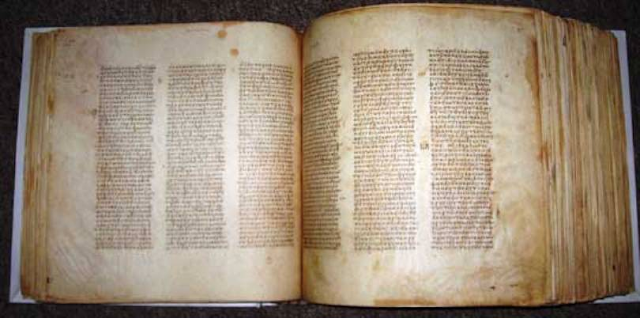Is the New Testament Historically Reliable?
I was not always a believer in Christianity. Until I was sixteen I was a nominal Catholic, then
I became an agnostic and remained one for 8 years. When I finally concluded that atheism was
illogical, I became a theist, but didn’t know what the right path to God was,
or if a right path even existed. Thus
for the next five years I critically examined the scriptures & teachings of
numerous faiths to try and determine where the truth was. When I first examined the New Testament, I didn’t
focus on theological teachings, mainly because I didn’t know much about
Christian theology at the time. However,
I did have a decent background in history and I initially decided to focus on
whether or not the New Testament was historically reliable. For me, if a document contains historical
flaws, then its reliability needs to be called into serious question. Therefore, I first focused on whether or not
the New Testament was historically trustworthy.
Suffice to say, I was amazed by my findings.
I first learned that the society and geographic locations described in
the New Testament were accurate. The cities
and towns cited to have existed in the region have been confirmed by archaeological
study. The divisions of Jewish society
(Pharisees, Sadducees, Zealots) is accurately described in the New Testament and
is also written of by other 1st century writers such as Flavius
Josephus. Historical figures mentioned
in the New Testament such as King Herod and the Roman Prefect of Judea, Pontius
Pilate, is also confirmed to have existed by both 1st century Roman
and Jewish sources. I determined that if
nothing else, the New Testament at the very least accurately described the
society of 1st century Judea. Nevertheless, I was still not convinced. After all, there have been many tall tales
written over the centuries, the legend of Beowulf being a prime example. Was Jesus just another example of Beowulf, an
ancient legend born out of imagination? Or
did he truly exist?
 |
| The Codex Vaticanus |
One criticism that I learned what that the New Testament had been written
many years after the supposed existence of Jesus. The earliest complete New Testaments copies
that we have are the Codex Vaticanus & the Codex Sinaiticus, both are dated
in the early 300’s, nearly 300 years after the death of Christ. However, what many fail to realize is that we
have over 24,000 New Testament Manuscripts from the second and third centuries. Over 5,000 are in Greek, nearly 10,000 in Latin,
& close to 10,000 in Syriac/Coptic. The earliest manuscripts are from the Gospel
of John in the early second century, only a few decades after the original
Gospel was written. This doesn’t even
take into account 36,000 manuscripts we have from 1st & early 2nd
century Church Fathers (Clement of Rome: AD 95, Ignatius of Antioch: AD 108 and
Polycarp: AD 110), that all quote repeatedly from the New Testament. When we compare the manuscripts and examine
their reliability based on textual criticism, it has been discovered that all
these manuscripts match up with 97-99% accuracy. The only discrepancies are in regards to
language translation, and these discrepancies are insignificant, they do not
change the overall meaning of the text. The
truth is, the New Testament is the best-preserved document we have from the Ancient
World.
To understand just how significant this manuscript evidence is, allow
me to cite some examples. Today there
are over 24,000 Bible manuscripts still in existence with them being only
50-225 years removed from the original.
On the other hand, the writings of Thucydides:
History of the Peloponnesian War, Livy: History of Rome, Julius Caesar: Gallic
Wars, & Pliny the Elder: Natural History only have between 7-19 manuscripts,
and they are dated 750-1000 years after they were originally written. Aristotle
is yet another example. Believed to have
been one of the most influential philosophers of Ancient Greece, the earliest
manuscript we have of his works is dated nearly a thousand years after his
death. Even The Iliad, which was considered the most important document of ancient
Greece, only has 643 manuscripts, with the earliest dated over 400 years after
the original was written. In truth, no
Ancient Document in the world is as well-recorded as the New Testament.
So now that we’ve covered the manuscript issue, let us consider the
issue of time. Scholars agree that the
Gospels of Matthew, Mark, Luke, and John are considered to be biographies of
Jesus. They also agree that the first three
Gospels were written in the early 60’s A.D., with some putting the Gospel of
Mark as early as 55 A.D. and John written around 90 A.D. Now Jesus, had he existed,
would have met his death at the hands of Pontius Pilate around 30 A.D., which
means that Jesus would have been dead for nearly 30 years before the First Gospel
was written. Is this too late to be
considered a reliable source? Absolutely
not! The earliest biography of Alexander
the Great that is still preserved was not authored until over 400 years after his
death, yet nobody questions whether or not he existed. The teachings of Buddha were not written down
until nearly 600 years after Buddha’s death.
The fact that all the Gospels were written within a few decades of the
death of Christ in the community of eyewitnesses is remarkable. In fact, some of the Letters of the New
Testament, such as Paul’s First Letter to the Corinthians, actually predate the
Gospels themselves. Most scholars agree that
the Apostle Paul wrote this letter a mere 20 years after the death of
Jesus.
The authors of the New Testament, The Disciple Matthew (Gospel of
Matthew), John Mark (Gospel of Mark, mentioned by name in the Book of Acts
& companion of the Disciple Peter), Luke (Gospel of Luke & Acts of the
Apostles, companion of the Apostle Paul), the Disciple John (Gospel of John),
along with the numerous Letters written by Paul, Peter, etc. all lived in the
First Century at the same time as Jesus himself. These authors either knew Jesus personally or
were close to others who knew him. Most
importantly, these writings were well preserved. The early Church Fathers who we mentioned
earlier were students of the Apostles themselves and they too had pupils to whom
they passed on the Gospels to in order to ensure their preservation. Cold case homicide detective J. Warner Wallace
studied this and became convinced that the chain of preservation was so strong
that he accepted that the Gospels were reliable accounts, and ultimately became
a Christian after being an atheist for most of his life.
The final note that must be considered is that there are 1st
& 2nd century sources from outside the Bible that help confirm
the New Testament. The Roman Historian
Tacitus, who lived from 56 A.D.-117 A.D. wrote about the Emperor Nero’s
persecution of Christians and confirmed in his writings that their leader, Jesus
had been crucified by Pontius Pilate.
The 1st century Jewish scholar Josephus not only mentions Jesus
in his writings, but also gave a detailed account of the execution of the
Apostle James (the Martyrdom of James is also described in the Books of Acts
& matches the account given by Josephus.). 2nd century Roman scholar Pliny
the Younger confirmed that the Christians applied divinity to Jesus, and 2nd
century writer Joseph Africanus quoted the writings of a 1st Century
Greek Historian Thallus who confirmed that there was darkness in the land of Judea
around the time that Jesus was believed to have been crucified. Late 1st Century Greek writer Mara
bar Serapion referred to Jesus as a “Wise King of the Jews,” and 2nd
century Greek rhetorician Lucian of Samosata mocked the Christians for applying
divinity to a crucified man. These are
all non-Christian writers, many of whom were hostile to Christianity, but they
never denied the existence of Jesus. All
of whom confirmed his existence and agreed with each other that Jesus was
Jewish, he was considered an influential leader of the Jewish community of the 1st
century, and he was crucified and executed on a Roman Cross.
Today, historical Jesus scholars from a variety of faiths debate on who
he really was, but none dispute that he existed. Quite the contrary. Even the most hardened atheists agree that the crucifixion and execution of Jesus at the hands of
Pontius Pilate is an indisputable fact of history. Thus after considering the factors of manuscript evidence, outside corroboration, archaeological findings, and the fact that was written by eyewitnesses, I came
to the conclusion that if nothing else, we can be certain that the New
Testament is a trustworthy historical document.
Sources:
Brooks, Rice. Man, Myth, Messiah. Nashville: W. Publishing Group, 2016.
Limbaugh, David. Jesus on Trial: A Lawyer Affirms the Truth of the Gospel. Washington D.C.: Regnery Publishing, 2014.
McDowell, Josh. More Than a Carpenter. Wheaton, IL: Tyndale House Publishers, Inc., 1973.
McDowell, Josh & Jim Walker. Understanding Islam & Christianity: Beliefs that Separate Us & How to Talk About Them. Eugene, OR: Harvest House Publishers, 2013.
Strobel, Lee. The Case for Christ. Grand Rapids, MI: Zondervan, 1998.
Wallace, J. Warner. Cold Case Christianity: A Homicide Detective Investigates the Claims of the Gospels. Colorado Springs, CO: David C. Cook, 2013.
White, James R. What Every Christian Needs to Know about the Qur'an. Minneapolis: Bethany House Publishers, 2013.




Comments
Post a Comment